
Store Ready Updated: 3/25/2024 Page 1 of 35
Meijer
Pallet, Packaging and
Store Ready Display
Specification

Store Ready Updated: 3/25/2024 Page 2 of 35
Contents
Objective..................................................................................................................................................... 4
Carton Specifications.............................................................................................................................. 5
Dimensions .............................................................................................................................................. 5
Labeling ......................................................................................................................................................... 6
Standard Carton Label Information .......................................................................................................... 7
GS1 – 128 Carton Label Information ......................................................................................................... 8
Carton Markings ..................................................................................................................................... 9
Color Banding – Imports ..................................................................................................................... 10
Load Condition Requirements ............................................................................................................ 12
Pallet Guidelines- All DF’s .................................................................................................................. 12
Unacceptable Pallets ........................................................................................................................... 13
Slip Sheets & Paper Pallets – Imports Only ..................................................................................... 13
Pallet Building Requirements .................................................................................................................. 14
Pallet Configurations ............................................................................................................................ 17
Securing Pallet for Transportation ..................................................................................................... 18
Trailer/Container Loading .................................................................................................................... 19
Shipping: Compliance and Debits ..................................................................................................... 20
PDQ (Product Displayed Quickly) Proposals and Approvals .................................................... 21
PDQ (Product Displayed Quickly) In-Store .................................................................................. 21
Common Area Corrugated Displays Proposals ........................................................................... 21
Inner Guidelines for PDQ Design .................................................................................................. 21
Presentation Guidelines .......................................................................................................................... 22
Shelf Displayer Definitions ...................................................................................................................... 22
Shelf Displays ....................................................................................................................................... 22
Shelf Displays (examples) .................................................................................................................. 23
Shelf Displays ....................................................................................................................................... 24
Shelf Display Trays .............................................................................................................................. 24
Carded packaging display tray guides .............................................................................................. 25
Carton Printing Information for Store Display ...................................................................................... 25
Shelf Fillers ................................................................................................................................................ 26
Fastrack Program ................................................................................................................................... 29
Additional Carton Guidelines For Own Brand Products ............................................................. 30
Store Ready Updated: 3/25/2024 Page 3 of 35
Folding Cartons and Window Boxes ................................................................................................. 31
Blister/Blister Card Combinations ...................................................................................................... 32
PVC Clamshell Packaging .................................................................................................................. 32
PVC Bags .............................................................................................................................................. 33
Poly Bags............................................................................................................................................... 33
Paper/Paperboard Materials ............................................................................................................... 34
Store Ready Updated: 3/25/2024 Page 4 of 35
Objective
This guide provides information on the carton specifications, packing requirements, pallet and display
specifications, as well as pallet labeling and shipping obligations. The objective of this guide is to provide
the Meijer vendor community the necessary details to ensure compliance to Meijer guidelines when
shipping to a Meijer Distribution or Store site. To view additional Meijer requirements, refer to the Meijer
Vendor Requirements & Reference Guide and the International Logistics Guide on the Meijer VendorNet
under Vendor Documents> Guides.
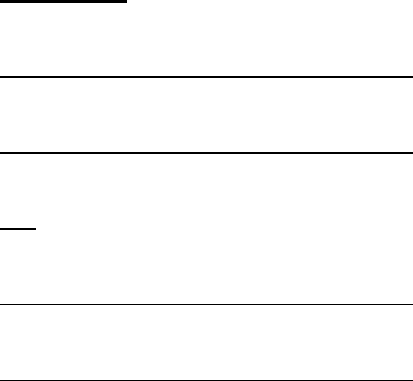
Store Ready Updated: 3/25/2024 Page 5 of 35
Carton Specifications
Dimensions
• Packaging must be designed to suit the corresponding weight of the package and to comply with
forces that occur during transportation and storage, including suction of the layer and selection
process
• Affix lid at the carton (e. g. adhesive tape)
• Tops and bottoms of cases must be taped or glued
• Product in a loose case must be shrink-wrapped
• Case size min and max for being able to utilize the conveying process through the Distribution
Facilities are as follows.
Dry Grocery
Lansing – 86, 84; Tipp City – 805; Newport – 881; Pleasant Prairie – 871
Minimum:
L W H Weight Cube
9“ 6” 3” 5lbs .09
Maximum:
L W H Weight Cube
26.5” 22” 28” 75lbs 9.45
GM
Lansing – 93; Tipp City – 802
Minimum:
L W H Weight Cube
9“ 6” 6” 5lbs .188
Maximum:
L W H Weight Cube
26” 20” 28” 70lbs 8.43

Store Ready Updated: 3/25/2024 Page 6 of 35
Labeling
• Labels are to be free of any obvious non-conformances (poor print quality, voids, tears, etc.) that
are readily noticeable at arm’s length
• Labels materials and adhesives must be designed to withstand normal distribution channels
including containerization, LTL and full truck/trailer environments and distribution facility handling
• Meijer utilizes bar coding technology to receive product at stores and distribution sites.
o Any barcode or UPC printed on labels must be readable at a Grade ‘B’ or better
• Meijer intends to follow bar-coding guidelines set forth by the GS1 US.
• The exterior of the carton must be labeled using one of the following methods based on the
purchase order type/distribution method:
o Standard Carton Label - cartons containing one UPC (product or shipper)
o GS1- 128 Carton Label - cartons containing multiple UPC’s and logistical units (carton)
is packed for designated store.
For review GS1 standards, visit their website for additional information, http://www.gs1.org
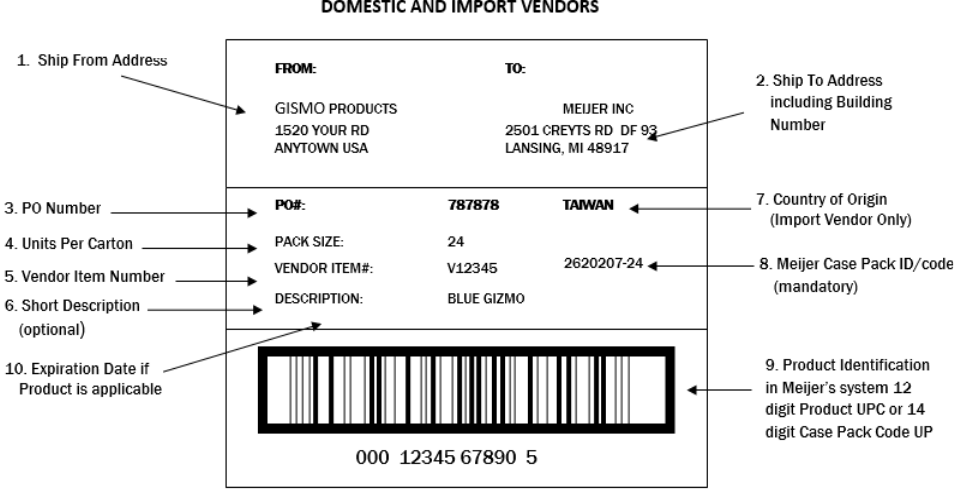
Store Ready Updated: 3/25/2024 Page 7 of 35
Standard Carton Label Information
The information below must be clearly marked and legible on every Standard Carton, either printed on the
carton or printed on a label and affixed to the carton.
1. A “Ship From” address
2. The “Ship To” address including the store number
3. The Purchase Order number
4. Units Per Carton/Pack Size/Selling Units Per Master Carton
5. Vendor Item #/Style# (recommended, but not required)
6. Short Description (optional)
7. Country of Origin (required on sellable unit)
8. Meijer Case Pack ID/code number (mandatory)
9. Product Identification - 12 digit Product UPC (selling unit) or 14 digit Case Pack UPC. UPC if
listed on the PO, UPC must be both scanable and legible. UPC on label must exist in
Meijer’s product system, as shown on Purchase Order.
10. Expiration Date if product is applicable.
11. Additional information such as Size/Size Range and Color may be required based on your
product category (ex. fashion garments)
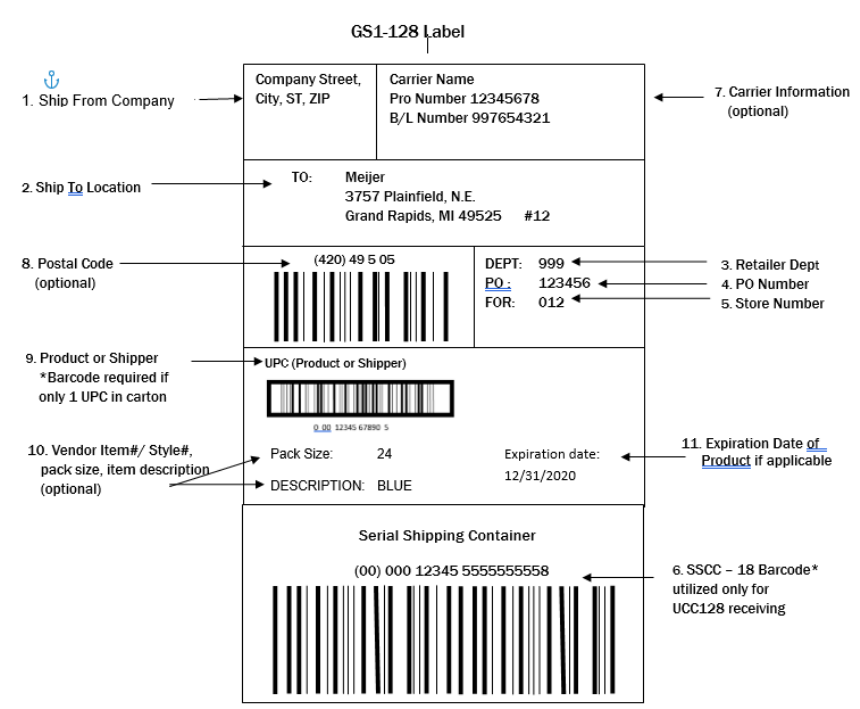
Store Ready Updated: 3/25/2024 Page 8 of 35
GS1 – 128 Carton Label Information
The information below must be clearly marked and legible and represents all product within the
carton/logistical unit, either printed on the carton or printed on a label and affixed to the unit.
1. A “Ship From” Address
2. The “Ship To” Address including the store Number
3. Retail Department (optional)
4. Purchase Order Number
5. Marked for destination if shipping to a DC and Marked for Store
o Example: If product is shipping to a DC, the final destination would be the store
number that the product is packed for
o If carton/logistical unit is not marked for Store, the Product or Shipper UPC must be
in both readable and scannable format for receiving
6. SSCC 128 number and barcode for pick and pack cartons
7. Carrier Information (optional)
8. Postal Code (optional)
9. Product or Shipper UPC in human readable and scannable barcode form is mandatory if
using GS1-128 carton label for carton containing one product or shipper
10. Vendor Item #/Style#, Pack Size, and Item Description (optional)
11. Expiration Date of product if applicable
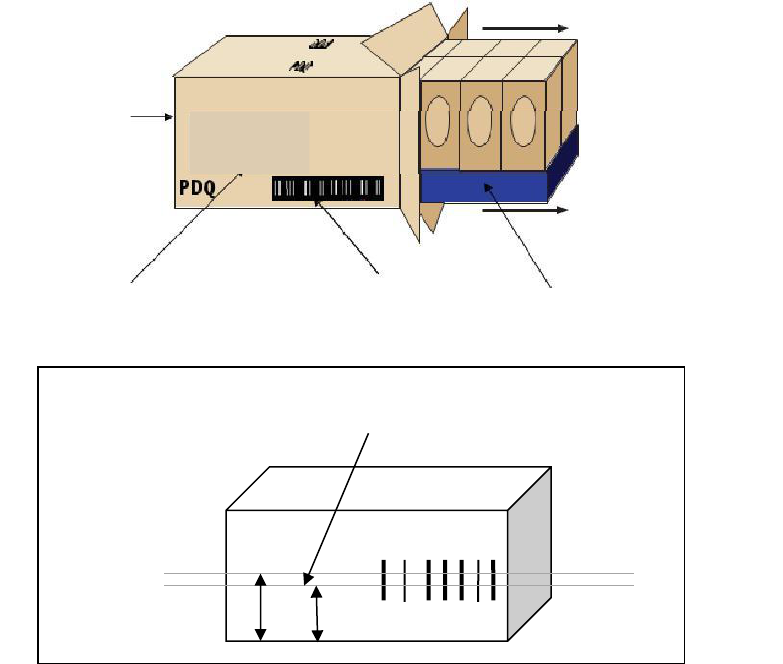
Store Ready Updated: 3/25/2024 Page 9 of 35
Carton Markings
• Carton labels shall be positioned on top, front, or side of carton
o Do not position carton label on bottom of carton
• Carton markings must be placed to be scanned without changing case orientation
• Label must be one inch from corners, ends, and seams
• Lines of the scanable barcode shall not be creased
• Barcode is read between 1.38 – 1.90 inch range on the carton
• 14 digit case pack GTIN’s must be registered in Meijer’s system
• Cartons must also include weight, length, and height on the side of each carton
• If multiple cartons, can include carton# of # on label
OPENING PROCEDURES
We
Inner Pack Labeling (if case pack is set up with inners greater than 1, the inner packing
needs to be labeled with:
• Product UPC
• Inner Pack Quantity
• Banding if applicable
•
ITEM DESCRIPTION INFORMATION
WAREHOUSE
MARKING
ECT.
PDQ TRAY
QUANTITY AND
WEIGHTS
Quantity
2 lb. .
Barcode is read in this range
1.90 Inch
1.38 Inch
Quantity and
Weights
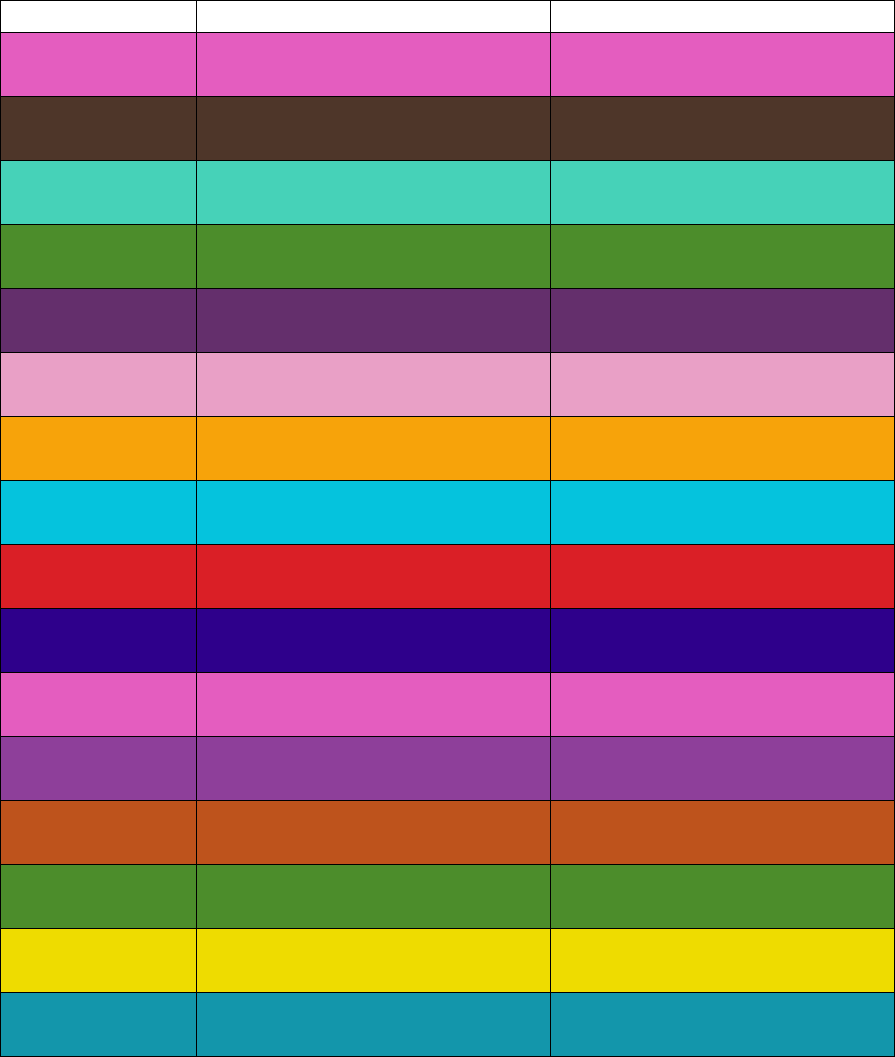
Store Ready Updated: 3/25/2024 Page 10 of 35
Color Banding – Imports
• Master color codes grid for specific seasonal departments
• Bands should include Department and Season
• Used for stores and DF for easily identifying seasonal cartons
• The color-coded band should be visible on all four sides of the box
Color
Season
Department
PANTONE 238
VALENTINE'S DAY
Seasonal, Card & Party, Home,
Crafts
PANTONE 476C
BLACK HISTORY
Card & Party, Home
PANTONE 3533U
GARDEN CENTER
Aisle
PANTONE 363
ST PATRICK'S DAY
Card & Party, Mens, Womens,
Childrens, Home
PANTONE 520
EASTER/ SPRING
Seasonal, Card & Party, Home,
Crafts
PANTONE 672C
WOMEN HISTORY
Card & Party, Home
PANTONE 137
GARDEN CENTER
Seasonal Pad
PANTONE 311
AMERICANA/ PATRIOTIC/
GRADUATION/ MEMORIAL DAY
Seasonal, Card & Party, Mens,
Womens, Childrens, Home, Crafts
PANTONE 185C
PRIDE
Card & Party, Home
PANTONE 2735C
BACK TO SCHOOL
School Home Office, HBC, Crafts
PANTONE 238
BACK TO COLLEGE
Home, DIY
PANTONE 2593C
HISPANIC HERITAGE
Card & Party, Home
PANTONE 167
HALLOWEEN
Seasonal, Card & Party, Home,
Crafts
PANTONE 363
HUNTING SEASONAL
Sportings Goods
PANTONE 3965
HARVEST
Seasonal, Card & Party, Home,
Crafts
PANTONE 2396U
THANKSGIVING
Card & Party
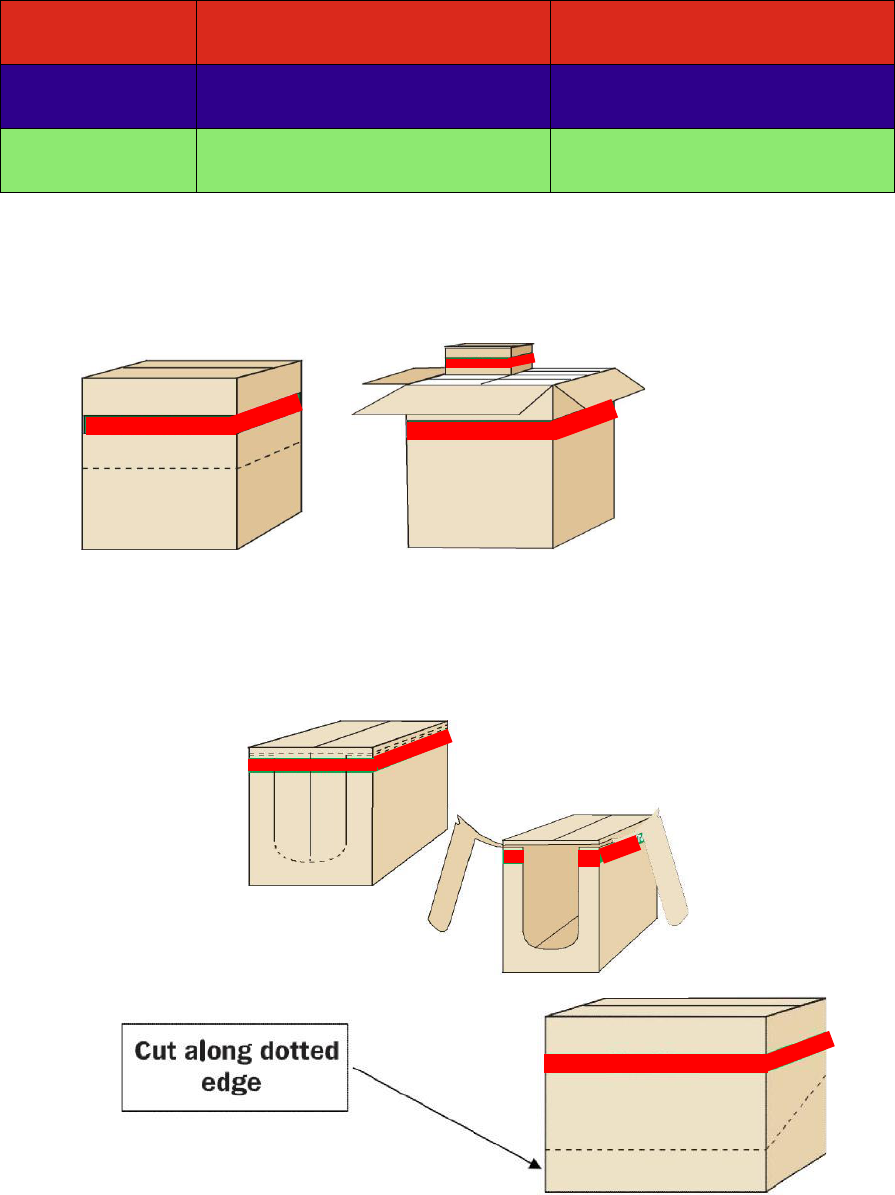
Store Ready Updated: 3/25/2024 Page 11 of 35
PANTONE 485
HOLIDAY
Trim A Tree, Card & Party, Home,
Crafts
PANTONE 2735C
WINTER SEASONAL
Sportings Goods
PANTONE 902C
SUMMER CAMPING/ TAILGATE
GAME
Sporting Goods
• Band must be located on upper half of the carton (as shown in the illustrations below)
• Boxes taller than 12" height require a 4” color coded band
Boxes less than 12" height require a 2” color coded band
Cut Case Carton Marking
When cartons are to be cut for use as a display unit (PDQ) follow identifying illustration for carton as
shown below to reduce the chance of damaged goods.
REQUIREMENT: Perforated lines that do not require a box cutter reduces damage
For cartons that use a pull tab opening system as a display unit (PDQ) follow identifying illustration for
carton as shown below to reduce the chance of damaged goods.
REQUIREMENT: Opening procedures must be clearly specified
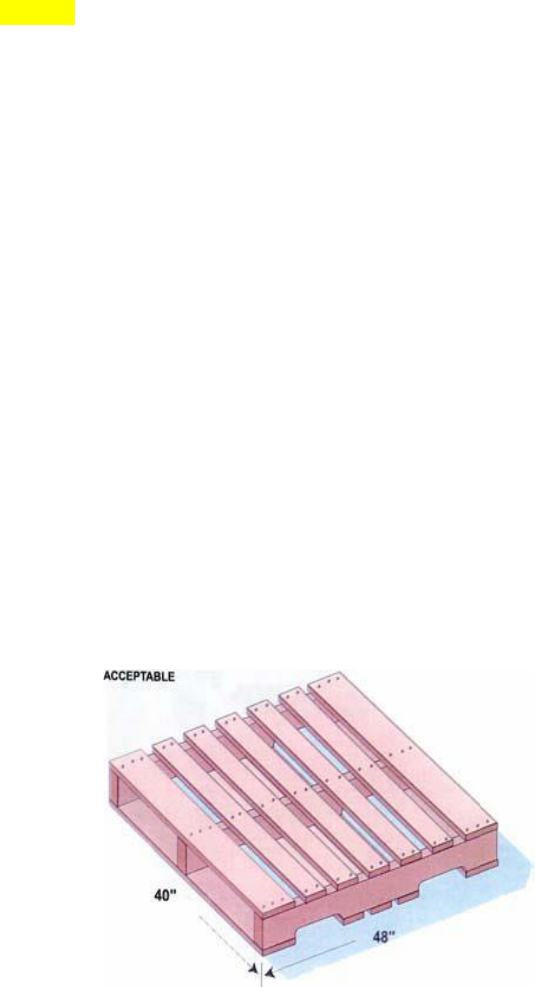
Store Ready Updated: 3/25/2024 Page 12 of 35
Load Condition Requirements
Pallet Guidelines- All DF’s
Meijer requires that all pallets, including shipper and display pallets, meets or exceeds the quality
standards established by the Grocery Manufacturers Association, including, but not limited to, the
following minimum acceptable requirements:
• Grade A, 4-way pallet, Measurements maximum height of 60”
• Full Pallet– 48"W x 40”D
• Pallets shipped to DF 90, have a maximum height of 33”
• All top and bottom boards securely attached to stringers/runners
• Material - Group III and or/Group IV hardwood clean saw
• Grade - Material free of knots that are larger than 1/3 the width of the board
• Boards to be free of serious imperfections to avoid total pallet failure
• Nailing - Nail pieces together use 8-02-1/2” driver screw nail. Stagger at nailing joint.
• Top Deck Boards - 7 boards, 5/8" to 3/4" evenly spaced with 4" maximum spacing. Both end
boards 5 1/2", other boards 3 1/2".
• Bottom Deck Boards - both end boards and a minimum of 3 center boards, same board
dimension as top deck boards. No loose boards
• Stringers/Runners - not split through or broken, no double stringers /runners or block patched
stringers/runners
3 stringers/runners (1 3/8" - 1 3/4" x 3 1/2" - 3 3/4" x 48")
• Pallet fumigation certificate – mandatory for customs inspection on import goods
• If plastic pallets are used, only bar coded IGPS are acceptable; no other plastic pallets can be
used. Plastic IGPS pallets may be used in all DF locations EXCEPT Frozen buildings.
• Shipper displays can be banded to pallet in order for display to withstand transport through the
Meijer supply chain. Carton banding is not permitted.
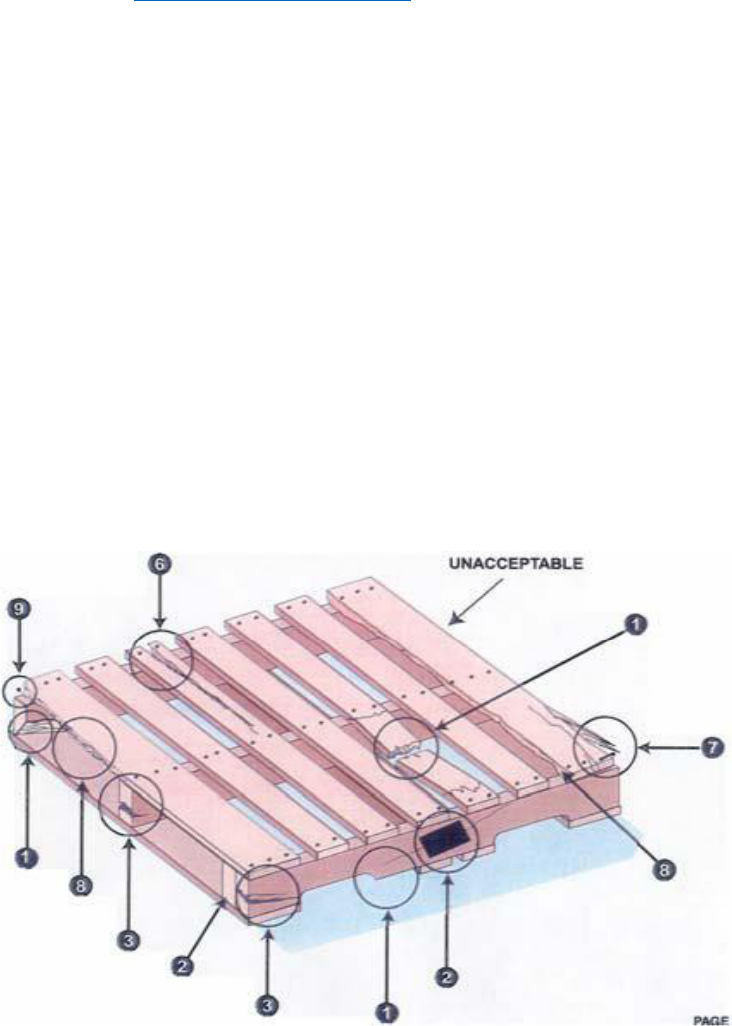
Store Ready Updated: 3/25/2024 Page 13 of 35
Unacceptable Pallets
Pallets meeting any of the following conditions are unacceptable: For visibility to pictures of unacceptable
pallets and restacks please visit http://meijerportal.fhiworks.com or the Meijer VendorNet Orders &
Payments>Payments & Claims> Restack Portal
1. Missing, broken, or unsecured boards on top or bottom
2. No double stringers/runners, metal repair plates or patched boards
3. Broken and/or visibly cracked stringers/runners (excluding weathering cracks which are not
continuous and not visible from three sides).
4. Contamination by dirt, debris, stains, grease, chemicals, any other material that would soil or
damage the product or its container, or odors.
5. Cracks on top or bottom boards greater than 1/8” wide and 15 “in length
6. Exposed splinters greater than 3” in length
7. Tapered breaks with a depth of greater than 1” along a 10” or more run
8. Nails, nail heads, or nail points exceeding 1/8” exposure from the surface of wood (pallets are not
to be rejected for exposed nails unless top or bottom board surface between nail head and
stringer/runner has been destroyed)
9. Partial footings, where a 1/4 or a stringer board width or length connecting to a bottom board has
been removed or securing nail shanks are exposed in the stringer
10. Missing leading edge> ½” in any place
11. Missing, split or cracked blocks horizontal or vertical) visible from two sides ( Only CHEP and
PECO pallets with blocks are allowed, white wood block pallets are not allowed).
a. Twisted blocks > outside perimeter
Slip Sheets & Paper Pallets – Imports Only
All vendor factory loaded import containers should be floor loaded, or on a slip sheet. Any import
container that is not shipping floor loaded or on a slip-sheet must be pre-approved by Meijer before
shipment booking.
Note: Meijer does not accept paper pallets on Import containers.

Store Ready Updated: 3/25/2024 Page 14 of 35
Pallet Building Requirements
Pallet Building Requirements for Display Pallets – All DF’s:
• Pallet Requirements
o Half Pallet – 48”W x 20”D - Must ship on top of a full pallet.
o Quarter Pallet – 24”W x 20”D- Must ship on top of a full pallet.
• Merchandise must not overhang pallet footprint
• Height must not exceed 60” including merchandise
• Pallets should be wrapped with corrugated shroud (200# C Flute material) and cover (C flute
material) or with angle board, shrink wrap, or cover.
• Display units need to be (1) individually shrink wrapped and (2) shrink wrapped together to a
grade A pallet for transport. This ensures that the product does not fall out of the displayer if 2
half pallet displayers are separated during the receiving process.
• Half and Quarter display units need to be placed on a full pallet and secured for transit.
• Each pallet shall have Meijer routing information and color banding on the exterior of the
shipping carton, refer to Color Banding section
• All trays should use coated stock (if display is seasonal, contact buyer for appropriate PMS color)
• All fillers left in the display during merchandising MUST match or be complimentary to the main
elements of the display (ex. if the outside of the pallet display is printed blue, all visible fillers
and dividers should also be blue)
Pallet Building Requirements for Witron DF’s 84, 89, 807 and 871:
• All product shall be delivered on pallets
• Merchandise must not overhang pallet footprint. Pallet contour should ensure goods are not
stacked up to the pallet edge. The minimum gap should not be less than 50 mm (2 inches) per
side
• Shrink wrap must cover the product to the top board of the pallet. Shrink wrap must be clear.
• All case flaps must be secured
• Layers may not be glued or waxed
• Slip sheet acceptable between pallet and first layer of product
• Pallet covers are acceptable on select commodities. Please have prior approval.
• Maximum layer weight: 250 kg (551 pounds)
• Maximum pallet weight: 1,250 kg (2,755 pounds) including the pallet
• Pallet must be a single-item pallet or have single-item layers
• All cases on a pallet should have the same case orientation
• A UPC must be consolidated onto one pallet within a purchase order and should not be on
multiple pallets for the same PO unless the quantity exceeds the space on one pallet
• Items ordered in case quantities should be placed towards the top of the pallet
• Bagged items should be palletized with bagged items and boxes should be palletized with boxes.
Bagged and boxed items should not be shipped on the same pallet.
• Slip Sheets
o Should only be utilized if the product is not stable for 10 seconds of being unwrapped
o If the product is in a corrugated box slip sheets are not needed
o Slipsheets should only be utilized if product does not have a transport container for the
selling unit.
o The only exceptions are bagged pet food, bagged sugar, and bagged flour where a slip
sheet is needed to ensure nails from the pallet do not puncture the bags.

Store Ready Updated: 3/25/2024 Page 15 of 35
o Slip sheets can be utilized at a pallet break location so that the top layers can be pulled
from the pallet.
Not Acceptable Pallet Building Components Witron DF’s 84, 89, 807 and 871:
• No slip sheets between layers of product. Slip sheets can be utilized at a pallet break location so
that the top layers can be pulled from the pallet.
• Plastic straps or adhesive foil used for transport or to secure layers is not permitted
• No incomplete layer pattern (ex. packages are missing, holes in between product)
• Multiple Purchase Orders cannot be mixed on the same pallet
• There should be no pallet overhang which includes packaging material sticking out too far
• Product cannot be “Chimney” stacked and must be arranged horizontally in layers
Pallet Building Requirements for DF’s 85,86,90,93,801,802, 804,860,872,881,882 and 883:
• All product shall be delivered on pallets
• Merchandise must not overhang pallet footprint.
• Shrink wrap must cover the product to the top board of the pallet.
• Shrink wrap must be clear.
• Same items should be arranged in horizontal layers on the pallet
• Slip sheets are acceptable between pallet and first layer of product
• Pallet covers are acceptable on select commodities. Please have prior approval.
• Packages per layer must have the same height
• Each pallet should be labeled with a PO #.
• Multiple purchase orders may be combined on the same pallet provided the pallet is marked as
a “Mixed Pallet” and the purchase order numbers are clearly visible
• A UPC must be consolidated onto one pallet within a purchase order and should not be on
multiple pallets for the same PO unless the quantity exceeds the space on one pallet
• PO’s must be sorted and segregated by pallet. If only one pallet is needed and multiple PO’s are
shipping to the same DF, then the freight must be segregated on the pallet by PO#.
Not Acceptable Pallet Building Components for 85,86,90,93,801,802, 804,860,872,881,882 and 883:
• There should be no overhang of the load over the pallet edge which includes packaging material
sticking out too far
• Layers may not be glued or waxed
• No slip sheets between layers of product. Slip sheets can be utilized at a pallet break location so
that the top layers can be pulled from the pallet.
• Plastic straps or adhesive foil used for transport or to secure layers is not permitted
• No incomplete layer pattern (ex. packages are missing, holes in between product)
• Multiple Distribution Facilities cannot be mixed on the same pallet
ART (DF 86) Inner Pack Packing Requirements to ensure items will be handled safely and accurately in
our automated system:
• the mpak must be securely bundled so that the units can withstand a drop of 16” into the
bottom of a plastic tote without compromising the banding/packaging securing the mpak
selling units together.
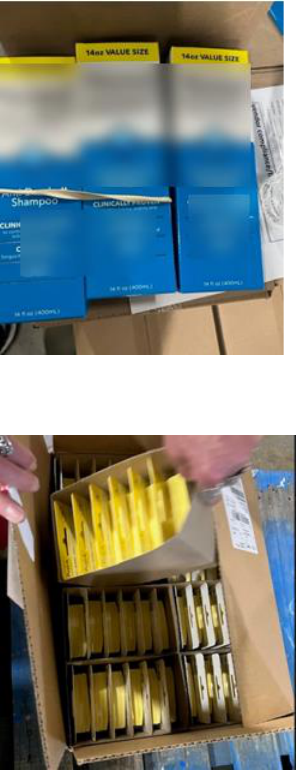
Store Ready Updated: 3/25/2024 Page 16 of 35
• the items must be securely wrapped/ packaged to withstand a drop of 16” into the bottom
of a plastic tote without incurring any damage to the customer selling unit (IE glass and hard
plastic items should be individually wrapped for protection)
• Rubber bands are not sufficient to hold mpak’s together. Items can fall out of this banding
during handling.
• Open ended cardboard trays are not sufficient to hold the mpak’s together. Items can fall
out of this packaging during handling.
• Lightweight plastic banding that does not keep the mpak’s together as the banding is not
secure around the items.
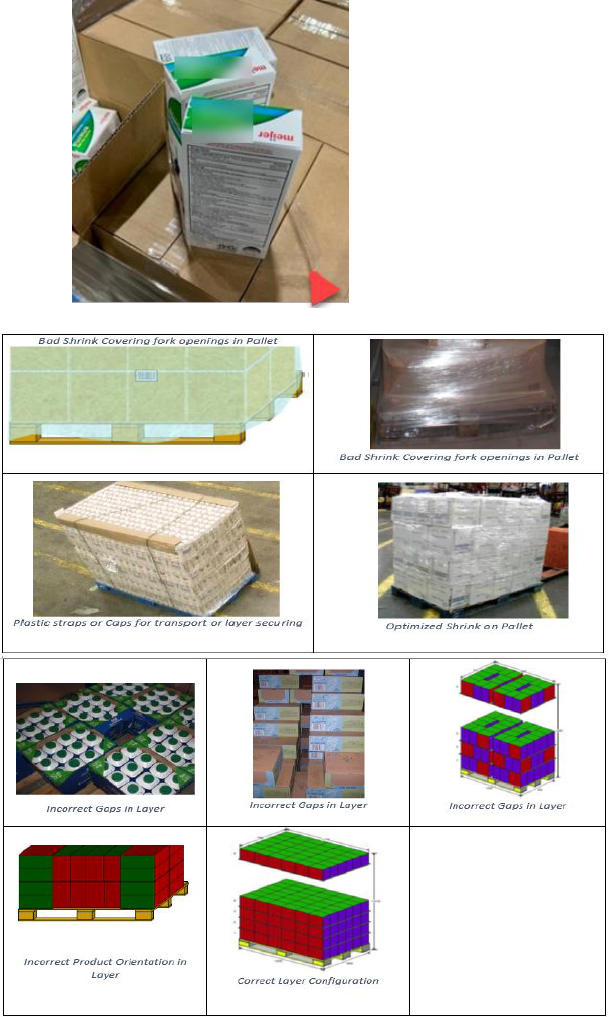
Store Ready Updated: 3/25/2024 Page 17 of 35
Pallet Configurations
• Interlocking Stacking:
o Single item pallets
o Each layer is arranged in opposing directions (Example B-H)
o Stacking method creates greater load stability
o Drastically affects stacking compression of master cartons and PDQ’s.
o If all four corners of the container misalign, it results in the following:
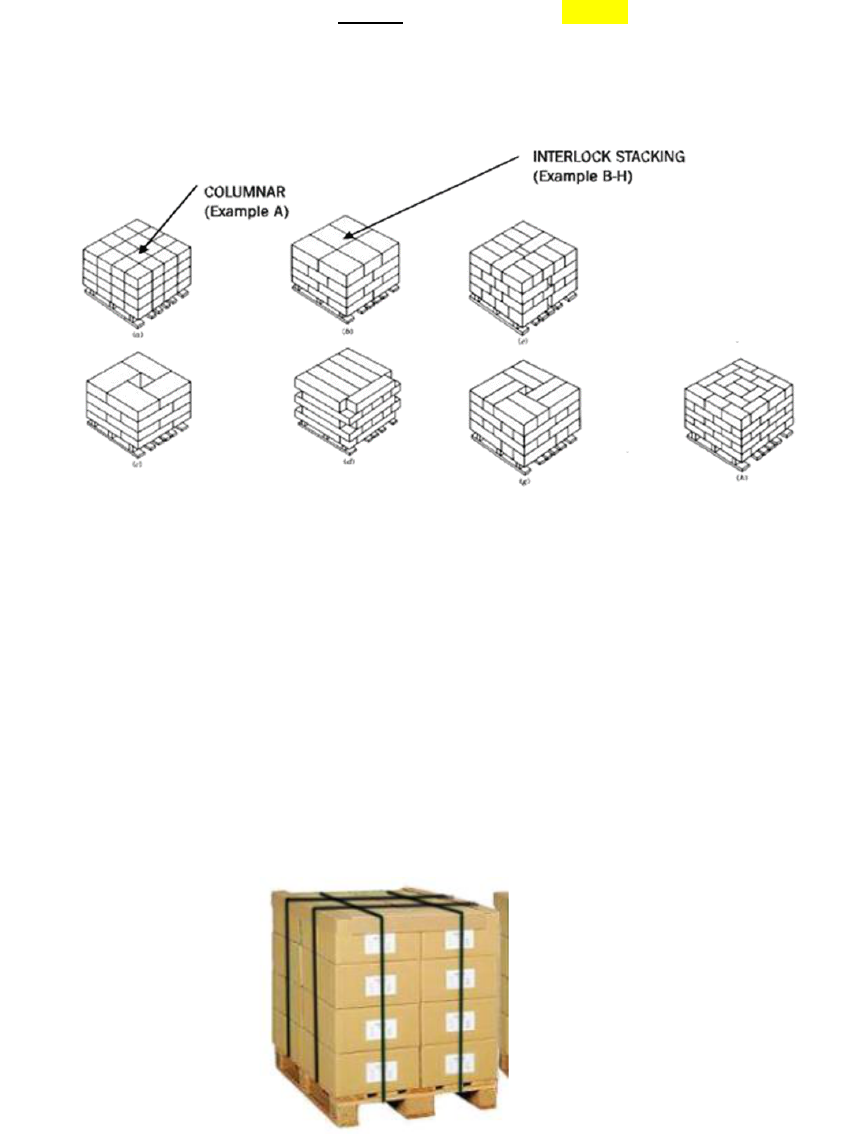
Store Ready Updated: 3/25/2024 Page 18 of 35
▪ 45% to 55% loss in compression strength but improve load stability
▪ Columnar Stacking should only be used if master carton or PDQ needs additional
crush protection
• Columnar/Chimney Stacking (cannot be used at DF89,DF 807,DF871,DF84)
o Multiple items on a pallet
o Stacking arrangement for best box compression strength is vertical columns (Example A)
o When stacking in columnar as shown in Example A, ensure that boxes are properly
aligned and use a tie sheet between layers to ensure stability
Securing Pallet for Transportation
Vendor is required to take necessary measures to ensure product can move safely and securely through
the Meijer Supply Chain to final store destination.
Responsibility of Vendor/Manufacturer:
• All pallets should be built in a stable manner
• ½ and ¼ pallets must be positioned on top of a pallet and not be floor loaded as ½ or ¼ pallet
• Properly test proposed shipping and display units
• Utilize full shroud, cap and banding restraints
• Heavy and unstable items shall be properly restrained from shearing movements during
transportation and handling
Note: compression forces acting on packaging will loosen the restraining bands over time
• Glue or adhesive must withstand vibrations/movement during transit
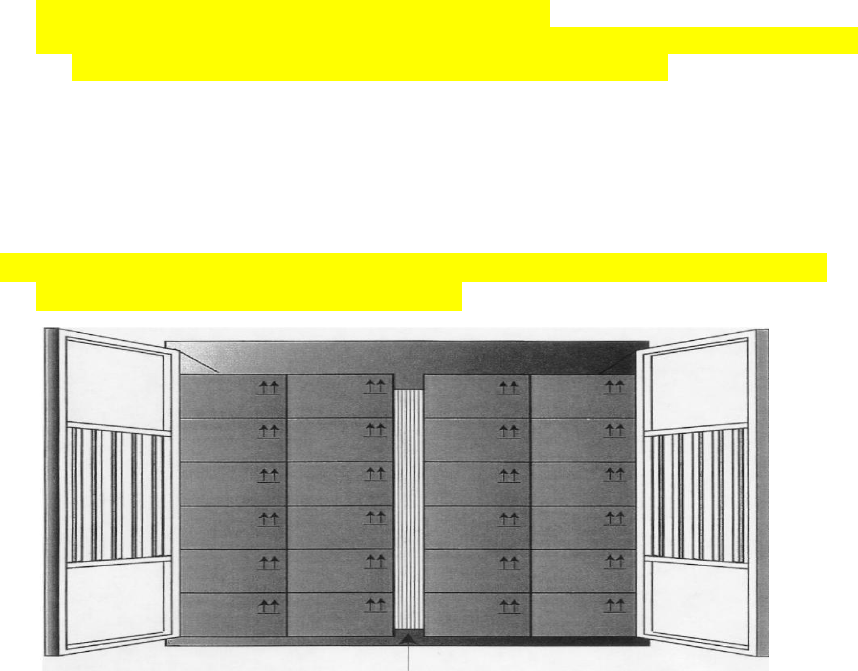
Store Ready Updated: 3/25/2024 Page 19 of 35
• Packaging must be secured. No loose edges which may jam or damage equipment
• Plastic wrapping around individual items should be sturdy (ex. bath tissue, paper towels)
• Items should not be in open cases where product can fall out; they must be in cardboard without
holes which is encased tightly with plastic
• All trays or flaps shall be securely glued
• Glass items must be separated by cardboard to eliminate contact breakage
• The below items are non-conveyable and thus exempt from these standards:
o Items classified as hazardous (ex. ammunition)
o Items that will poke from boxes (ex. bicycles peddles poking through the box)
o Items that cause the box to become rounded (ex. boat anchors and pillows)
o Liquid items deemed fragile where bottles may crack or the lids may work loose causing
damage to equipment
o Bagged items which may rip easily, causing damage to the equipment (ex. bagged grass
seed, bird seed, pet food, litter)
Trailer/Container Loading
• Trailer should be loaded by DF destination ( ie; 93,86)
• Trailer should be loaded by PO #, all pallets of PO# A should be segregated in the trailer.
Pallets for PO#A should not be intermingled with pallets for PO# B.
• Stacking Directly on top of the lower corrugated box is the preferred method; this is known as
columnar stacking. Vertical positioning of corrugated flutes provides the best support for stacking.
• Voids must be kept to the center of the container, and dunnage materials used to tightly hold
master carton. Shifting of master cartons during overland or sea travel must be kept to an
absolute minimum to ensure product arrives in good condition.
• Only clean trailers may be loaded as Meijer will reject trailers arriving dirty/infested.
• To expedite the unloading process, like items shall be loaded on a trailer together and not
mixed with other items throughout the shipment.
FLUTE DIRECTIONS: Indicate on outside of master carton as shown in illustration
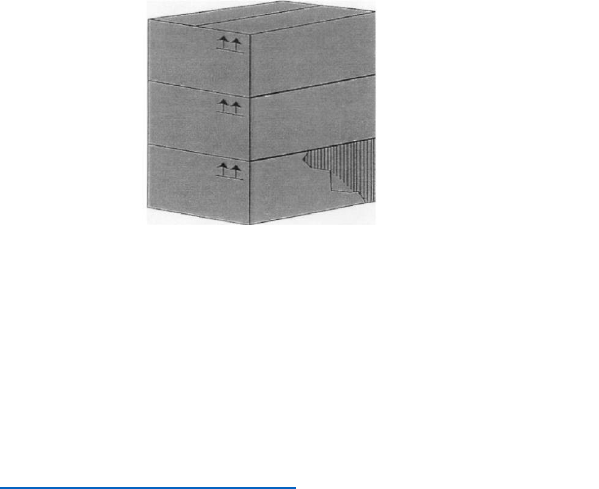
Store Ready Updated: 3/25/2024 Page 20 of 35
Shipping: Compliance and Debits
For debits related to the Meijer Load Efficiency Debit program, refer to the Vendor Requirements and
Reference Guide on the Meijer VendorNet > Shipping & Delivery > Guidelines & Requirements> Pallet,
Packaging and Store Ready Display Specifications located on the web at
https://www.meijervendornet.com.
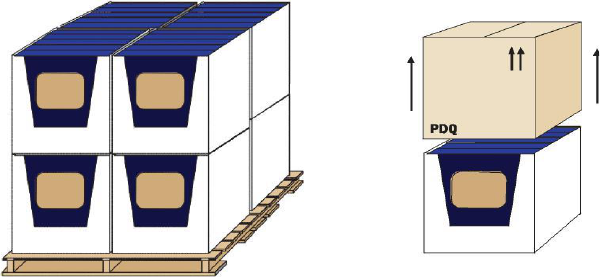
Store Ready Updated: 3/25/2024 Page 21 of 35
PDQ (Product Displayed Quickly) Proposals and Approvals
Send in PDF or JPEG Format to your Buyer, with final approval to be obtained from Meijer Packaging
Development, Merchandise Presentation, Visual Merchandising and Operations.
Recommendation for PDQ must include a digital photo or line illustration PDQs and must include the
following information when submitted:
• Store Display
• Shipment Unit
• Material Composition and Specifications
• PDQ Measurements Including Overall Length, Width and Height in Inches
• Proper Box Labeling – How you will be labeling and taping the box
PDQ (Product Displayed Quickly) In-Store
When stores receive PDQ’s, they will check planogram to confirm whether or not the PDQ is planned for
display purposes. In many cases the PDQ is necessary to display product appropriately. If PDQ is for
replenishment only, the PDQ can be discarded.
Common Area Corrugated Displays Proposals
Samples sent into 984 for Merchandise Presentation, Visual Merchandising, Merchandising and
Operations approval.
Inner Guidelines for PDQ Design
• Displayer tray (bottom) and shipper cover (top) designed with air space that is limited to 1/4” or
6.350mm
• Shipping cover must be securely attached with color coded tape
• Place information block with line drawing of unit on shipper cover, this indicates the display tray
within
• Shipper covers should be “brown kraft” in color
• Display trays must be white with product/merchandise description, unless seasonally relevant
• Seasonal display trays should match appropriate seasonal PMS color if applicable
• Display trays must use rolled edge design
• No raw edge designs are permitted
Store Ready Updated: 3/25/2024 Page 22 of 35
Presentation Guidelines
• Strong Visual Impact - 80% of the visual presentation (front and sides of shelf) should show
product, not signage
o GM and T-Aisle – The 48” side of the pallet will be the shoppable side facing the
department
o Foods Center Aisle – The 40” side of the pallet will be the shoppable side facing the
department.
• Clear View or Price - all shippers and temporary fixtures should allow for a clear view of shelf
price labels
• Guest Friendly - ensure the product is easy to shop with clean sight lines
• Timing - shippers and temporary fixtures should be used for three months or less
• Consistent Look - shippers and temporary fixtures should support an overall presentation strategy
• Maximize Capacity - shippers and temporary fixtures should be used to maximize capacity on the
selling floor if all the other guidelines are met. Product must have at least 7 days of supply using
the shipper.
Shelf Displayer Definitions
• Temporary Fixture (typically made from foam corrugated or chip board) - used to hold
product on a shelf. These temporary fixtures may include general information, signage
or verbiage that assists the guest in making an informed purchase.
• Temporary Shipper - any fixture that uses merchandise space to hold product on a shelf
that cannot stand alone, often times used on an end cap. Use of these fixtures must be
pre-approved by Meijer Merchandise Presentation, Visual Merchandising and Product
Development.
Shelf Displays
Prototype Displays:
• Vendor shall test all displays prior to shipping
• Most corrugated manufacturers test with an outside testing lab or in house testing
• Meijer Buyers review test results with Meijer Merchandise Presentation and Visual Merchandising
• Display vendor must provide specs for support and maximum weight allowance for each/peg
• Meijer Merchandise Presentation, Visual Merchandising, Merchandising and Operations approve
displays
Design Considerations:
• Displays shall be designed and manufactured to ensure durability for the duration of their set
period
• Vendor will work with buying team, Merchandise Presentation and Visual Merchandising to
determine acceptable display
• A display prototype filled with product/sent to planogram room for review is most efficient method
to complete this step display review process
Display Guidelines:
• Displays are not to exceed 60” high
• Displays over 60” high will not be accepted
• Displays must allow 10” to include both blue plastic pallet and wood pallet
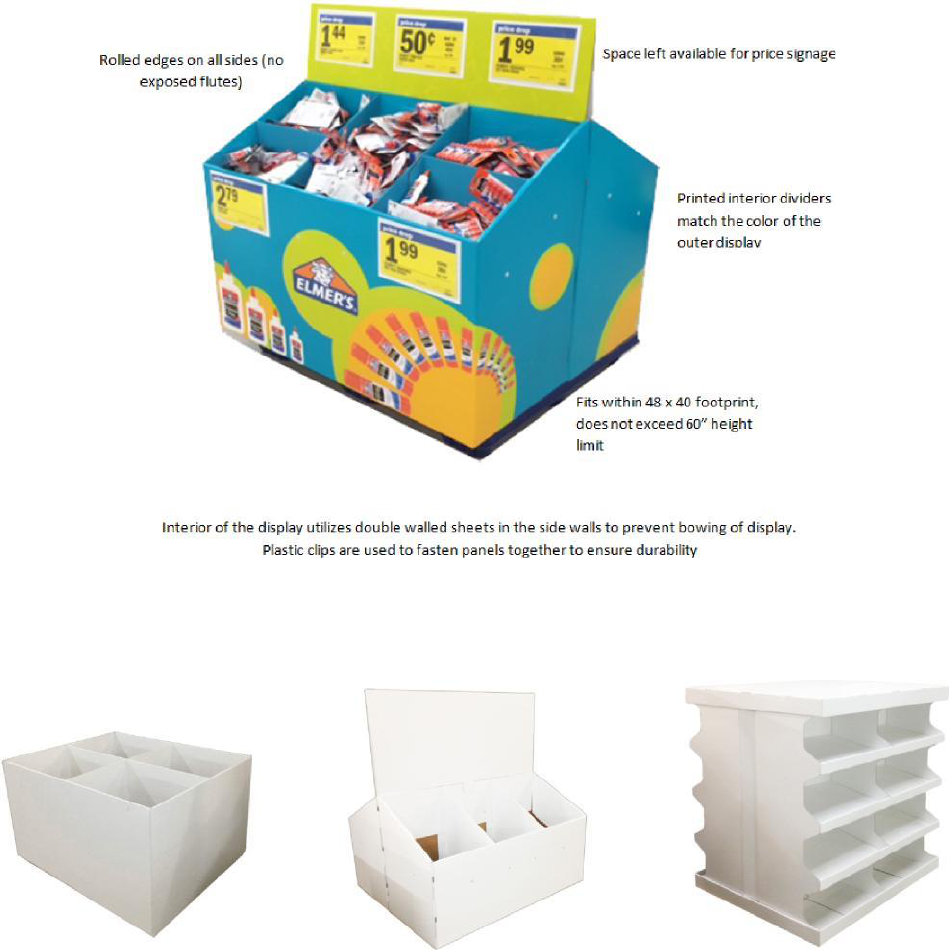
Store Ready Updated: 3/25/2024 Page 23 of 35
Shelf Displays (examples)
Example of a pallet display executed properly
Approved Meijer Specific Corrugate Shippers
4 Dump Bin 6 Dump Bin w/ Header Shelved Unit

Store Ready Updated: 3/25/2024 Page 24 of 35
Shelf Displays
• Can either be a display “shipper” (replaced with a new, pre-filled display as product sells) or “re-stock
able display” (needs to be re-stocked for the set period by store team members as product sells
down)
• Shippers and temporary fixtures:
o Easy to set up, stock, restock, and zone
o Meet end cap and shelf measurements- no overhang
o Sturdy and durable
o Disposition clearly communicated
o Product pricing clearly visible. Example, if using shelves allow enough space for a shelf strip
or tag to be applied to display.
• Where to use Shippers and Displays:
o End caps
o Inline
o Common Area
• Why to Use Shippers and Displays:
o Prototype fixtures & accessories will not support planned presentation
objectives
o Short set periods, where the cost of permanent fixtures exceeds sales
projections
o Anticipate positive impact on Store execution, stocking and zoning functions
o Business needs (major new product launches)
Shelf Display Trays
Display trays must be designed with a rolled edge and no unfinished or exposed corrugate edges. Raw
edge display trays are weak in comparison to rolled edge trays, in addition to presenting an undesirable
unfinished appearance.
Merchandise that shifts or nests together in the tray during shipment or customer handling is not acceptable.
Trays holding merchandise that are prone to shifting must use partitions to keep the product segregated.
Examples of such merchandise includes poly-bagged product such as dress shirts, pajamas, underwear or
carded items
.
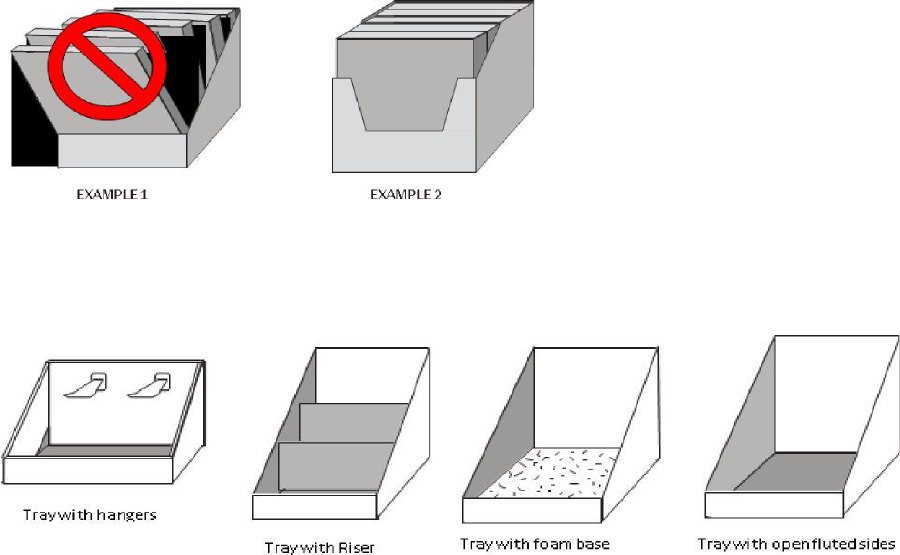
Store Ready Updated: 3/25/2024 Page 25 of 35
Packaged merchandise with a high center of gravity or a small base that has the tendency to fall forward
in the display tray (Example 1) should use a tray design that will limit the undesired forward movement
(Example 2).
Carded packaging display tray guides
There are many design possibilities for carded merchandise placed into display trays. Product packaging
should be evaluated to establish which design shown below would best support the merchandise with the
least amount of store maintenance required
.
Note: On narrow display trays as shown above, with the exception of the plastic hanger tray, it may not be
possible to roll the edge on all four tray sides as normally required. To maintain the best possible structural
integrity and presentation, front and rear edges of these trays are required to be rolled as shown.
Carton Printing Information for Store Display
Post Print to Corrugated (Flexo):
• Shipping containers and brand identities
• Printing process is directly to the corrugated liner board 2 and 3 color printing
• Most economical method has graphic limitations
• Limitations:
o Color registration between colors is limited to plus or minus 1/8" (1/4" overall)
o Limited to simple art or design
o 30 LPI Max recommended for halftone and screens
Litho Lamination (offset):
• Retail packaging smaller volumes
• Offset printed labels produced with 150 to 175 line screens
• Allows more possibilities in achieving great detail in graphics
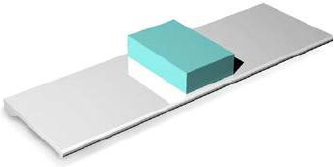
Store Ready Updated: 3/25/2024 Page 26 of 35
• Water based or UV coating for high luster finish is acceptable
• Limitations:
o Cost-effective with lower quantities only
o Hand Applied in most cases, but can be machine applied
o If not properly adhered to the substrate label, can come loose or create dog ears at
corners
o Apply glue to the label uniformly across entire surface, or seams become pronounced
• Materials:
o Minimum of 80# text enamel required
Pre Printer Liner (Flexo/offset):
• High volume retail packaging
• High quality printing 150 to 175 DPI required
• Flexography acceptable up to 133 DPI
• Can be printed at one location rewound and shipped to the converter for box manufacturing
• Printed with up to 6 colors (4cp+2, or 6 pantone)
• Limitation:
o Not cost effective for smaller runs
Shelf Fillers
“I” Shelf Filler (Information Box):
Teal Box (Information Box):
• Height will vary (recommended same as product height)
• Front width-maximum of 8 inches
• Depth – 13 or 19 inches (contact buyer to determine depth of shelves used to build POG)
• Graphics on front of box only
“L” Shelf Filler (Information Box):
Shelf Fillers
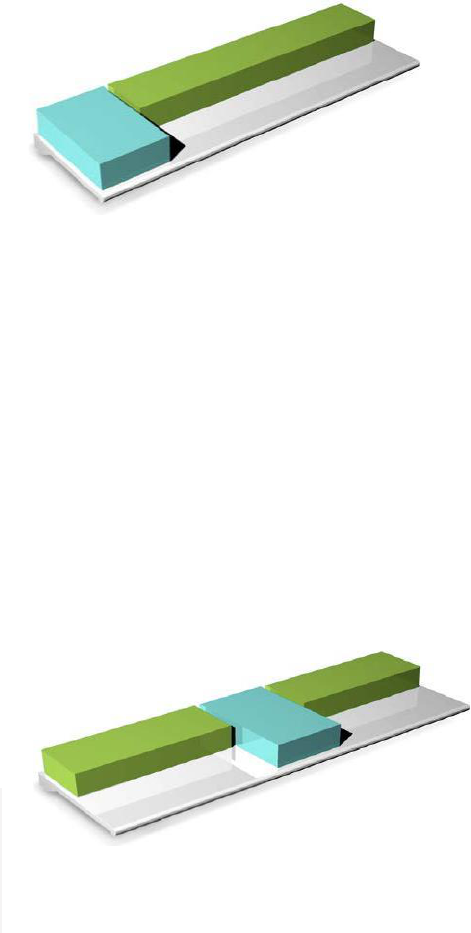
Store Ready Updated: 3/25/2024 Page 27 of 35
Green Box (Inventory Control):
• Height will vary (Recommended same as product height)
• Front width 28 inches
• Depth-maximum of 4 inches (purpose is to reduce shelf area)
• No graphics, must be flood coated a color
Teal Box (Information Box):
• Height will vary (recommended same as product height)
• Front width-maximum of 8 inches
• Depth – 13 or 19 inches (contact buyer to determine depth of shelves used to build
POG)
• Graphics on front of box only
“T” Shelf Filler:
Green Boxes (Inventory Control):
• Height will vary (recommended same as product height)
• Front width- each box 14 inches
• Depth - maximum of 4 inches (purpose is to reduce shelf area)
• No graphics (must be flood coated a color)
Teal Box (Information Box):
• Height will vary (recommended same as product height)
• Front width-maximum of 8 inches
• Depth – 13 or 19 inches (contact buyer to determine depth of shelves used to build POG)
• Graphics on front of box only
Shelf Displayers
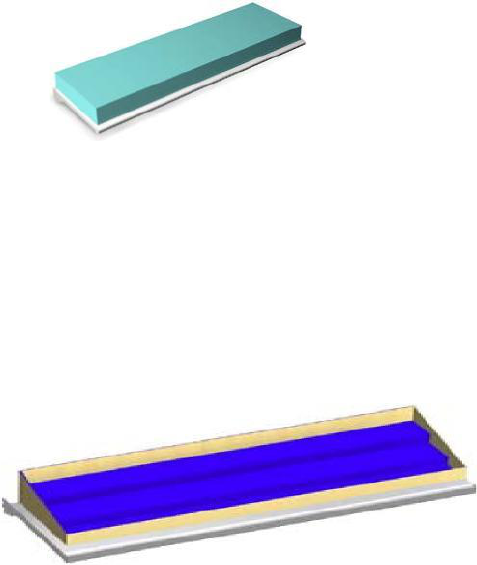
Store Ready Updated: 3/25/2024 Page 28 of 35
Launch Box Design Display Dimensions:
Teal Box:
• Height-Maximum 12”
• Front width-36 or 48 inches
• Depth - 13 or 19 inches (contact buyer for depth of shelves used to build POG)
• All graphics are limited to front panel
• Solid color must be flood coated on all other sides other than the front graphic
Stadium Shippers:
Requirements:
• Height will vary
• Front Width 36 or 48 inches
• Front lip 2 inches
• Depth 14 inches
• Minimum of 4 units per facing
• Minimum of 2 units deep per tier
• 8 inches or less dedicated to graphics
• Shipper must have a finished appearance as product is depleted
• One SKU per shipper recommended
• For multiple SKU’s, shipper must be single price point
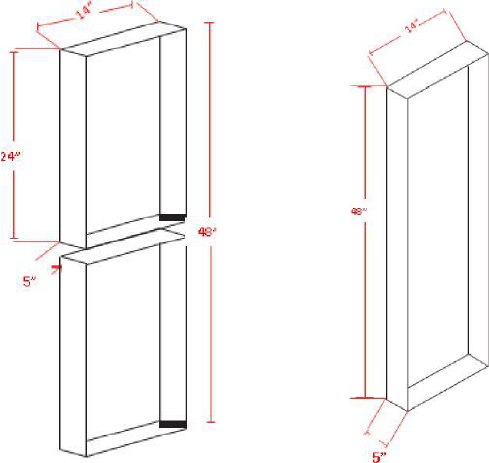
Store Ready Updated: 3/25/2024 Page 29 of 35
Fastrack Program
Designed to create incremental sales using Fastracks on the sides of end caps. Fastracks are placed
within the department, or cross-merchandising in other departments.
Fastracks Specifications:
• Pre-loaded
• Fastracks insert dimensions:
o 24" Tall x 14" Wide x 5" deep (shipped)
o 48” Tall x 14” Wide x 5" deep (shipped)
o Two 24" shadow boxes to be 48" overall
o 48" Tall
• Fastracks deeper than 5” must get Merchandise Presentation Manager approval
Fastracks Guidelines:
• Fastracks should be designed with front rolled edges (shown below)
• Minimum material = 200 pound "B" flute corrugated
• Material should be white coated stock
• Fastracks must be white in color with product/merchandise description, unless seasonally relevant
• Seasonal Fastracks shall be flood coated to match seasonal PMS Pantone
• Design sample and color match must be submitted to Meijer Visual Merchandising for approval
prior to issuance of Purchase Order
• Merchandise suppliers must properly load and mark the shipping carton showing correct
orientation to prevent spillage at store level
• All PDQ
shipper cartons are to be marked
with arrows indicating correct
orientation for shipping and handling as
noted in illustration
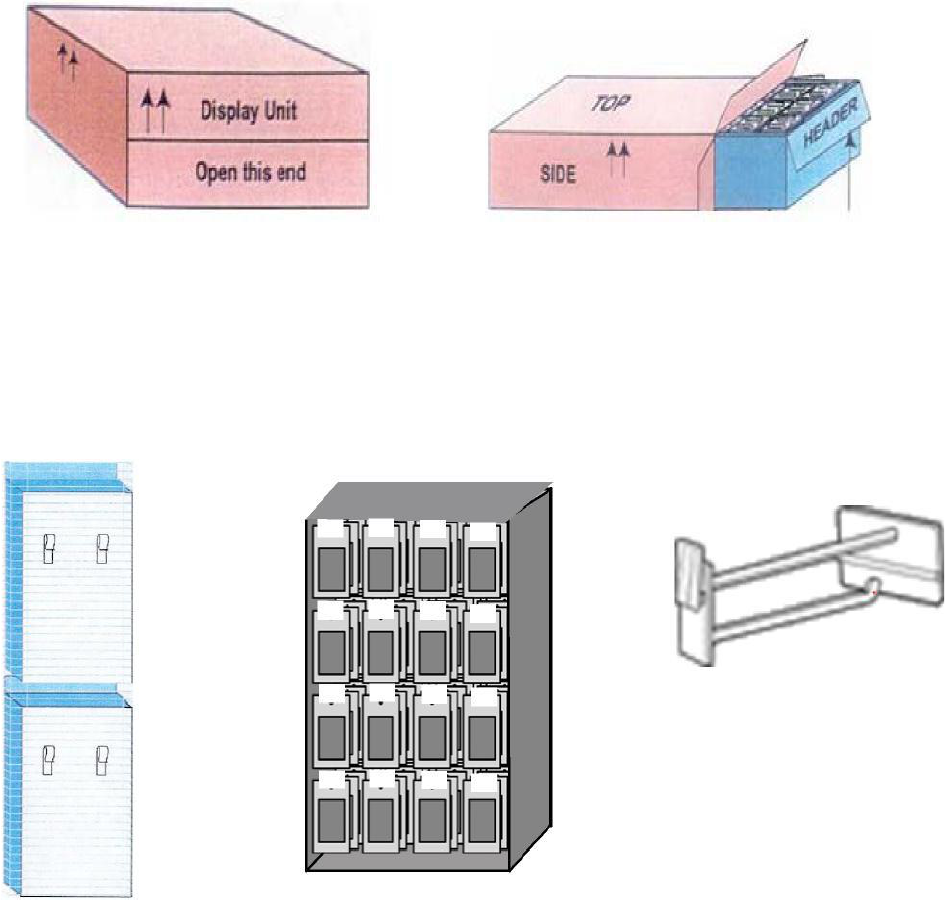
Store Ready Updated: 3/25/2024 Page 30 of 35
• All PDQ shipper cartons are to indicate correct opening procedures, i.e. "open this end" as noted
in Illustration below
• Fastrack displayer must be able to have a shelf tag at each facing location
Note: Carton Markings shown are in addition to all other Warehousing Marking/Labeling
Requirements
• Fastracks must have mounting system to allow for attaching on fastrack grid. Also must have the
ability to hanging shelf edge pricing tag.
• Designs that do not securely hold the product in place or that will lose structural integrity due to
rough use are not permitted
Additional Carton Guidelines For Own Brand Products
These are guidelines and not intended to be all inclusive of every situation, but rather a general point of
reference that defines quality and product protection for Meijer products.
Discuss your particular packaging needs or questions with your buyer and Package Development Team.
Store Ready Updated: 3/25/2024 Page 31 of 35
Folding Cartons and Window Boxes
• Paperboard folding cartons are to be constructed of SBS or CCNB paperboard with the
following minimum specifications:
o Thickness: Minimum 16 pt (0.4mm)
o
Basis Weight: Minimum 250 GSM
o Quality: Minimum C1S (for SBS only)
o Material: Minimum 50% virgin fiber
• For aesthetic purposes, plain, uncoated paperboard should not be used for primary packaging
unless otherwise instructed
• Cartons should not be constructed of a 100% recycled content paperboard
• Cartons may also be constructed of materials such as PVC, PE, PP or other approved materials.
• Folding cartons or window boxes should be designed with a tuck-top (including locking tabs) with
auto-bottom or snap-lock bottom design
• Display boxes may use alternative designs such as seal end or other designs, depending on
the product and its’ orientation. These designs must be reviewed and approved by Meijer for
own brand product
• Window box designs must have rounded corners at the cut-out to minimize potential for tearing
at the corners of the window
• For items weighing greater than 1 lbs. (0.45 kg.) but less than 5 lbs. (2.3 kg.) paperboard is to
be replaced with ‘E’ flute corrugate with the following minimum specifications:
o Thickness: Minimum 1/16” (1.5mm)
o Mullen Burst Test: Minimum 125#
o Edge Crush Test: 26 ECT
o Material: Single wall ‘E’ flute
• For items weighing greater than 5 lbs (2.3 kg) but less than 20 lbs. (9.0 kg.) ‘E’ flute
corrugate is to be replaced with ‘B’ flute corrugate with the following minimum specifications:
o Thickness: Minimum 1/8” (3.2mm)
o Mullen Burst Test: Minimum 175#
o Edge Crush Test: 32 ECT
o Material: Single wall ‘B’ flute
• Items greater than 20 lbs (9.0 kg) but less than 50 lbs (22.8 kg) are to utilize a ‘BC’ (‘B’ flute
and ‘C’ flute) double wall corrugate, with the following minimum specifications:
o Thickness: Minimum 9/32” (7.1mm)
o Mullen Burst Test: Minimum 200#
o Edge Crush Test: 42 ECT
o Material: Double wall ‘BC’ flute
Store Ready Updated: 3/25/2024 Page 32 of 35
• The outer liner for any corrugate carton must have a minimum basis weight of 250 GSM or
higher to minimize show through of the medium on the outer printed surface.
• For items weighing greater than 50 lbs. please reference Section 4 of this document “Large,
bulky or heavier (>50#) items.”
• For specification purposes, the following carton size nomenclature shall be used:
o L (1
st
dimension as shown in example drawings) x W
o (2
nd
dimension as shown in example drawings) x H
o (3
rd
dimension as shown in example drawings)
• Cartons, specifically corrugated, should be designed to either eliminate or minimize the
use of sealing tape upon final assembly.
• Any tape that must be used should be clear and applied in such a fashion to minimize the
aesthetic impact.
Blister/Blister Card Combinations
• Blisters shall be constructed of utility grade PVC void of any defects that would make the
package unappealing to the customer
• Clear thermoform materials (PETG, Barex, etc.) other than PVC may be used
• No holes or burn throughs are allowed in the blister
• Blister stock shall be no less than 12.5 mil (0.3mm) in thickness
• Blister cards shall be constructed of SBS or CCNB grade paperboard with the
following minimum specifications:
o Thickness: Minimum 16 pt (0.4mm)
o Basis Weight: Minimum 250 GSM
o Quality: Minimum C1S (for SBS only)
o Material: Minimum 50% virgin fiber
o Coating: Water or solvent based
• All blister/blister card combinations are to be face sealed to the card and are not to utilize an
insert or sleeve card type design.
• Blister to be face sealed to the card with a minimum fiber tear of 80% when blister is removed
from sealed card.
PVC Clamshell Packaging
• A minimum thickness of 15 mil (0.4mm) is to be used for all clamshell packaging
• Clear thermoform materials (PETG, Barex, etc.) other than PVC may be used provided pre-
production approval is gained from Meijer
Store Ready Updated: 3/25/2024 Page 33 of 35
• Clamshell to be constructed of utility grade PVC void of any defects that would make
the package unappealing to the consumer or retailer
• No holes or burn throughs are allowed
• Insert cards/header cards contained within the clamshell shall be constructed of bleached paper
or SBS paperboard (unless specified otherwise) and a minimum thickness of 10 pt (0.25mm)
• All clamshell seals should be RF sealed (no heat stakes), free of any voids or channels that
would allow contamination of the product held within or aid in the tampering with or pilferage of
the product
PVC Bags
• Basic vinyl bags shall be constructed of a minimum of 5 gauge (0.12mm) DPC (double
polished clear) PVC, free of wrinkles and made of a tear resistant consistency material
• Premium vinyl bags shall be constructed of 6 gauge (0.15mm) DPC (double polished clear)
PVC or higher, free of wrinkles and made of a tear resistant consistency material
• All PVC bags shall be free of voids or contaminates that would deem the product unappealing to
either the consumer or retailer
• Bags designed to hang should take into account the net weight of the product. Reinforced plastic
or steel grommets are to be used when necessary.
• Insert or header cards shall be constructed of bleached paper or SBS paperboard (unless
specified otherwise) with a minimum thickness of 10 pt (0.25mm). This may be lower for paper
inserts, but must be approved by Meijer
• Header cards are to be securely attached to the bags using galvanized or stainless
steel staples
• PVC bags with pockets included for insert cards are to be designed with the pocket sized
to match the size of the card appropriately (i.e. do not “oversize” pocket to accommodate
several different card sizes)
• PVC bags with zippers: Zippers are to be white in color (or color coordinated per Meijer direction)
and made of nylon construction
• PVC bags with piping or trim: Piping or trim is to be clear, white or color coordinated per Meijer
direction
Poly Bags
• Poly bags shall be constructed of a minimum of 1.5 mil (0.04mm) high clarity PE, PP, PVC or PET
and made of 100% virgin resin
• Insert or header cards shall be constructed of bleached paper or SBS paperboard (unless
specified otherwise) with a minimum thickness of 10 pt (0.25mm)
• Header cards are to be securely attached to the bags using galvanized or stainless
steel staples
Store Ready Updated: 3/25/2024 Page 34 of 35
Paper/Paperboard Materials
• Paper/paperboard materials used in packaging and not previously mentioned may include the
following:
o Adhesive cards/bands
o Cardboard holders
o Cardboard wraps
o Hang tags
o Sleeve cards
• Material specifications for these types of packaging may vary widely, but in general, paper and
paperboard materials are to be chosen with both product and shelf presence in mind
• Unlike other primary paperboard packaging materials, items in this category may use a lower
grade and thickness of paperboard and may contain a higher recycled content provided that the
paperboard is not used in a structural manner
• Final graphics are to be taken into account regarding material selection as lower grades of
paper/paperboard will have a negative effect on print quality and overall aesthetic
Store Ready Updated: 3/25/2024 Page 35 of 35
• Revision History
10/17/22 – Updated Color Banding to include additional colors for DEI Programs
3/27/17 – Updates per Sourcing and Import
7/7/17 – Removed Paper Pallet option for Imports and in slip sheet information
8/15/17 – Remove overhand allowance on pallets
02/01/18 – Changes to Carton Labels
12/18/18 – Changes to Carton Label – added back to college band
6/24/19 – Changes to Color banding
2/27/20 – Update to Carton Label/marking – added Thanksgiving color band, added in additional
pallet sizes
3/31/23 – Changes to Color banding
7/13/23 – DF ART Product updates, Inner Labeling Update
